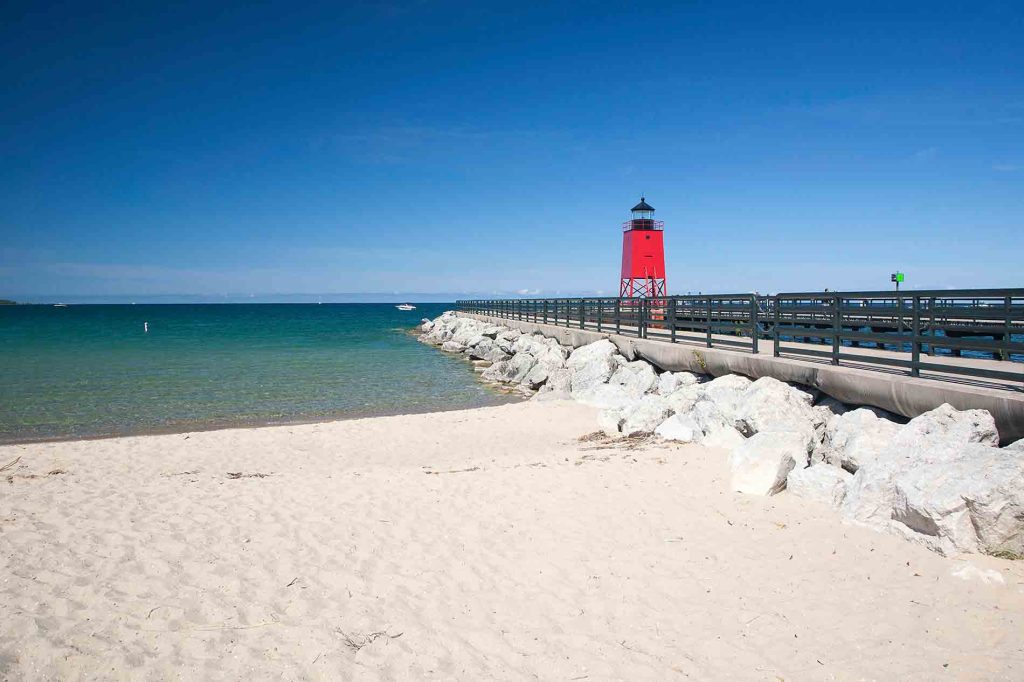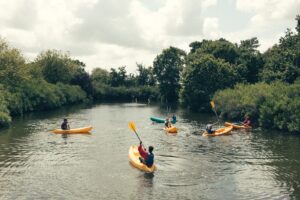
Charlevoix Beaches
Charlevoix has beaches on Lake Michigan and also offers the warmer swimming waters of inland lake beaches on Lake Charlevoix.
The Mackinac Bridge is the 10th largest suspension bridge (over water) in the world. It connects Michigan’s Upper and Lower Peninsula over the Straits of Mackinac, where Lake Michigan and Lake Huron meet. Mackinaw City is located at the southern point of the bridge, and St. Ignace at the northern point. I-75 is the highway that crosses the bridge. which starts from Sault Ste. Marie and ends north of Miami. The total length of the suspension bridge is 8,614 feet, with the total length of the bridge at five miles. Close to 500,000 vehicles cross the Mackinac Bridge during the summer. That number drops to around 169,000 in January. Annual vehicle crossing is approximately 4,000,000.
As far back as 1884, discussions were being held regarding the need for a bridge or tunnel between the Upper and Lower peninsulas. After the construction of the Brooklyn Bridge in 1883, interest grew for a suspension bridge of this type to span the Straits of Mackinac. The Board of Directors of the Grand Hotel on Mackinac Island reiterated the great need for a bridge to bring tourists to the island during the summer season.
Over the next 50 years, many ideas were presented, from a floating tunnel to a series of bridges and causeways from Cheboygan, around Bois Blanc and Round Islands, to Mackinac Island and finally St. Ignace.
Ferry service was started around 1923, but the traffic became so heavy that once again plans for a bridge were resurrected. In 1934, the Mackinac Straits Bridge Authority of Michigan was formed. During the next ten years, grants and loans were applied for, plans were drawn up, and a 4,200 foot causeway from St. Ignace was constructed. Then WWII began and all bridge progress came to a halt until 1947.
Finally in 1953, financing through a group of investment companies was the catalyst to finally begin the bridge project. Maintenance of the structure would be paid for from license plate and gasoline taxes. The great engineer Dr. David B. Steinman was hired for the design of the Mackinac Bridge and construction officially began in May of 1954.
After three years, the Mackinac Bridge was open to traffic on November 1, 1957. Total cost to build the bridge was $99,800,000. During construction five men lost their lives, and a monument in their honor was erected. In 1997, a bridge painter fell to his death, bringing the death toll to six.
Mackinac Bridge Authority
N. 415 I-75, St Ignace, MI, 49781
(906) 643-7600

Charlevoix has beaches on Lake Michigan and also offers the warmer swimming waters of inland lake beaches on Lake Charlevoix.

Summer’s not summer without a day at the beach and Northern Michigan offers some of the best beaches anywhere.

Built during World War II to haul heavy materials during the winter, the Icebreaker Mackinaw was in service for 62 years then became a museum.

Wildlife sanctuary Thorne Swift Nature Preserve is located 3 1/2 miles north of Harbor Springs, between Lower Shore Drive and Lake Michigan.

Petoskey State Park is one of the premier destinations for campers and outdoor lovers and is tucked away between Petoskey and Harbor Springs.

The elegantly restored Cheboygan Opera House is an acoustically superb, Victorian theatre that presents entertainment of many genres.

Harbor Springs, Michigan has a vibrant, beautiful downtown business district complete with a beach, waterfront, shopping, dining, parks, and more!

The arts, history and many types of entertainment in Northern Michigan mean visitors can enjoy fabulous music, theatre, and culture.

Northern Michigan has many varied settings for kayaking- whether it by river, one of the inland lakes, or Lake Michigan,